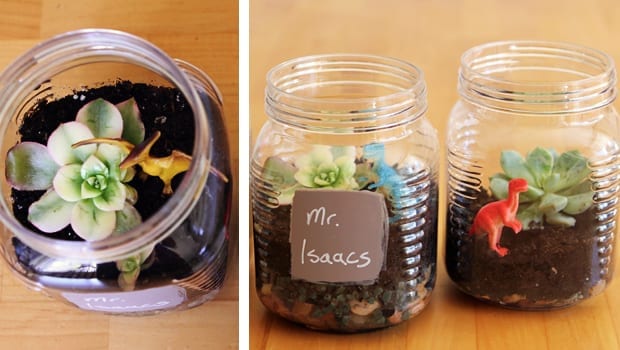Welcome to our DIY Crafts series! DIY Crafts is focused on crafts that we have done, crafts that we will do and crafts that others have done that we feel deserve the “Craft Spotlight“. We invite you to check back often as we share these projects with you. You can view all of the DIY Crafts by visiting our DIY and Arts & Crafts section.
Now that summer is upon us, it’s time to think of fun crafts to do – crafts that your kids are sure to enjoy. While browsing the store the other day, I saw a handful of $1 succulents and even a few terrariums on display. So, I got to thinking.
I came home and did a quick internet search and found this amazing article that talks about making mini terrariums and even giving them to teachers are gifts. What a great back-to-school gift!
Photo Credit: Stephanie Morgan
A terrarium is most known for simulating a dry habitat, for instance, a desert or savannah. A terrarium can also be formed to create a temperate woodland habitat, and even a jungle-like habitat. This can be created with pebbles, leaf litter and soil. By misting the terrarium, a natural water cycle occurs within the environment by condensation forming on the lid causing precipitation.
Many kinds of plants are suitable for these habitats, including Bromeliads, African Violets, Succulents and Crassulaceae.
For your mini terrarium, you will need the following:
– Clear glass or plastic container
– Small rocks, pebbles
– Activated charcoal
– Potting soil
– 1 – 3 small plants
– Decorative figurines
Many terrariums come in two basic forms which are open and enclosed, each of which caters to different varieties of plants.
Of course, open terrariums are best suited for drought-resistant plants, such as cacti and succulents which is what I prefer. The best thing about it is these plants are very hardy and require little maintenance (ie – your thumb can be hardly green to keep these plants alive). These are also great for people who don’t have a lot of time to care for plants or who want to give these as gifts to friends without committing them to daily waterings. Nothing says a “gift” like giving someone a plant that they must strive to keep alive, right?
Another option would be an enclosed terrariums, which is known to require more attention and must provide a perfect environment for tropical plants, such as ferns and mosses. While these terrariums are higher maintenance, they also provide more opportunities for learning because each forms its own miniature ecosystem.
Once you decide on a terrarium setup, gather your plants. Choose small plants that won’t grow to more than 6 inches tall. In the interest of keeping our terrarium small, we decided to use a single plant. If you want a grouping, keep in mind that odd numbers and varying heights usually look best. Also, it’s essential to choose plants that require the same kind of care. Check the labels on the plants to be sure they’ll get along well. – Note from source.
Steps:
Clean your container with hot, soapy water. Have your child put in a drainage layer of small stones about 1 inch thick so the plant’s roots won’t sit in water. (Gather stones on a nature walk or buy them at your local gardening center.)
Next, add a thin layer of activated charcoal to help filter the water. The best place to find this is in the aquarium or terrarium section of a pet store.
Finally, add a layer of soil suited to the type of plants you’re using. For our open-air, drought-resistant terrarium, we used a slow release soil meant specifically for cacti and succulents.
Combined, the drainage and soil layers should take up about one-quarter to one-half of the terrarium’s vertical space. (Keep this in mind when selecting your plants. In the end, our vibrant red cactus didn’t make the cut because it was too tall.)
Depending on the size of your container’s opening, use either a spoon or a skewer to dig a hole about twice the size of your plant’s root ball. After loosening the plant’s root ball, place it into the soil. Add a little more soil and pat everything down. Finish up by watering the soil.
Now’s your chance to add a little whimsy. Let your child pick out something, or someone, fun to keep the plants company.
A quick care reminder: Drought resistant terrariums need lots of indirect sunlight and the soil should dry out before waterings.
Read more: Make a Mini Terrarium | eHow Mom
Contributor
We have guest bloggers on our site often. It's a great way for others to share their ideas and opinions with us all. If you're interested in contributing in some way, feel free to contact us and we would be happy to chat with you.





Leave a Comment